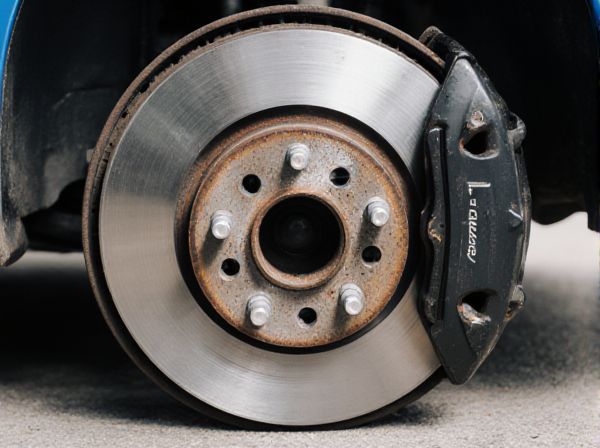
Photo illustration: Drum Brakes vs Disc Brakes
Disc brakes provide superior stopping power and heat dissipation compared to drum brakes, making them ideal for high-performance or heavy-duty vehicles. Drum brakes, while generally less expensive and simpler to maintain, can suffer from brake fade under prolonged use and provide less consistent braking performance. You should choose disc brakes for better safety and reliability in demanding driving conditions.
Table of Comparison
| Feature | Drum Brakes | Disc Brakes |
|---|---|---|
| Design | Enclosed drum housing with shoes | Exposed disc rotor with calipers |
| Heat Dissipation | Poor, prone to overheating | Excellent, resists brake fade |
| Stopping Power | Lower stopping force | Higher, consistent braking |
| Maintenance | Complex and time-consuming | Simple and quicker servicing |
| Durability | Wears faster under heavy load | Longer lifespan under stress |
| Cost | Lower initial cost | Higher upfront cost |
| Common Usage | Older and economy vehicles | Modern and performance cars |
Introduction to Drum Brakes and Disc Brakes
Drum brakes feature a set of brake shoes inside a drum that rotate with the wheel, creating friction to slow the vehicle when the shoes press outward against the drum. Disc brakes use a caliper to squeeze brake pads against a spinning rotor, providing more efficient heat dissipation and consistent stopping power. The fundamental structural difference impacts performance, maintenance needs, and common applications in various vehicle types.
How Drum Brakes Work
Drum brakes operate by pressing brake shoes outward against a spinning drum attached to the wheel, using hydraulic pressure from the brake fluid. This friction slows down the wheel's rotation and effectively reduces vehicle speed. The enclosed design helps protect the braking components from dirt and moisture, contributing to their durability in certain applications.
How Disc Brakes Operate
Disc brakes operate by using calipers to squeeze brake pads against a spinning metal disc, creating friction that slows down the vehicle. This system provides better heat dissipation and consistent stopping power compared to drum brakes, especially under high-performance conditions. The hydraulic mechanism in disc brakes ensures faster response time and more precise control during braking.
Key Differences Between Drum and Disc Brakes
Drum brakes utilize a set of brake shoes that press outward against a rotating drum, offering effective braking power but generating more heat and prone to fade under heavy use. Disc brakes feature a caliper that squeezes brake pads against a spinning disc rotor, providing superior heat dissipation, enhanced stopping power, and better performance in wet conditions. The main differences lie in their design, heat management capabilities, and overall braking efficiency, with disc brakes favored for high-performance and safety-critical applications.
Performance Comparison: Drum Brakes vs Disc Brakes
Disc brakes provide superior stopping power and heat dissipation compared to drum brakes, making them more effective under high-performance conditions. Drum brakes tend to experience brake fade due to heat buildup, reducing their efficiency during prolonged or heavy braking. The exposed nature of disc brakes also allows for better water and debris clearance, enhancing consistent braking performance in various driving environments.
Durability and Maintenance Requirements
Drum brakes generally offer greater durability due to their enclosed design, which protects components from dirt and debris, leading to longer service intervals compared to disc brakes. Maintenance for drum brakes is often more complex and time-consuming because of their intricate internal mechanisms, whereas disc brakes allow easier inspection and faster replacement of pads. Despite disc brakes requiring more frequent maintenance, they provide superior heat dissipation and consistent performance under heavy braking conditions.
Cost Analysis of Drum Brakes vs Disc Brakes
Drum brakes typically cost less to manufacture and replace compared to disc brakes, making them a budget-friendly option for many vehicles. Maintenance expenses for drum brakes can be higher due to more frequent adjustments and slower heat dissipation causing quicker wear. However, disc brakes offer longer durability and better performance, which may reduce overall lifecycle costs despite their higher initial price.
Safety and Heat Dissipation Capabilities
Disc brakes offer superior safety due to their enhanced heat dissipation capabilities, which reduce the risk of brake fade during prolonged use or heavy braking conditions. The exposed rotor design of disc brakes allows for better air circulation, efficiently cooling the braking components and maintaining consistent stopping power. In contrast, drum brakes tend to trap heat within the enclosed drum, leading to decreased braking performance and increased risk of brake failure under intense or repeated braking scenarios.
Applications: Best Uses for Each Brake Type
Drum brakes excel in applications requiring cost-effective and robust braking systems, such as in trucks, buses, and parking brake mechanisms due to their superior heat retention and lower maintenance costs. Disc brakes deliver superior performance in high-speed, high-heat environments including passenger cars, motorcycles, and racing vehicles, providing better heat dissipation, more consistent stopping power, and improved wet-weather performance. Choosing the appropriate brake type depends on vehicle weight, driving conditions, and the need for braking precision and durability.
Choosing the Right Brake System for Your Vehicle
Choosing the right brake system for your vehicle depends on factors such as driving conditions, vehicle type, and maintenance preferences. Drum brakes offer better performance in low-speed, heavy-load situations and are typically more cost-effective, while disc brakes provide superior stopping power, heat dissipation, and performance in high-speed or wet conditions. Evaluating these characteristics ensures optimal safety, efficiency, and durability tailored to your specific driving needs.
 caratoz.com
caratoz.com